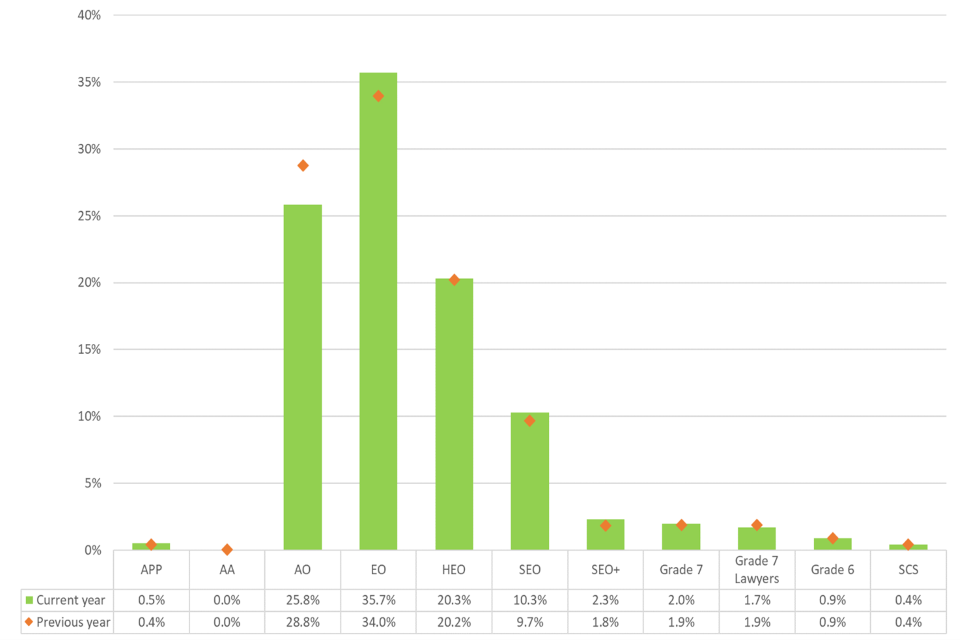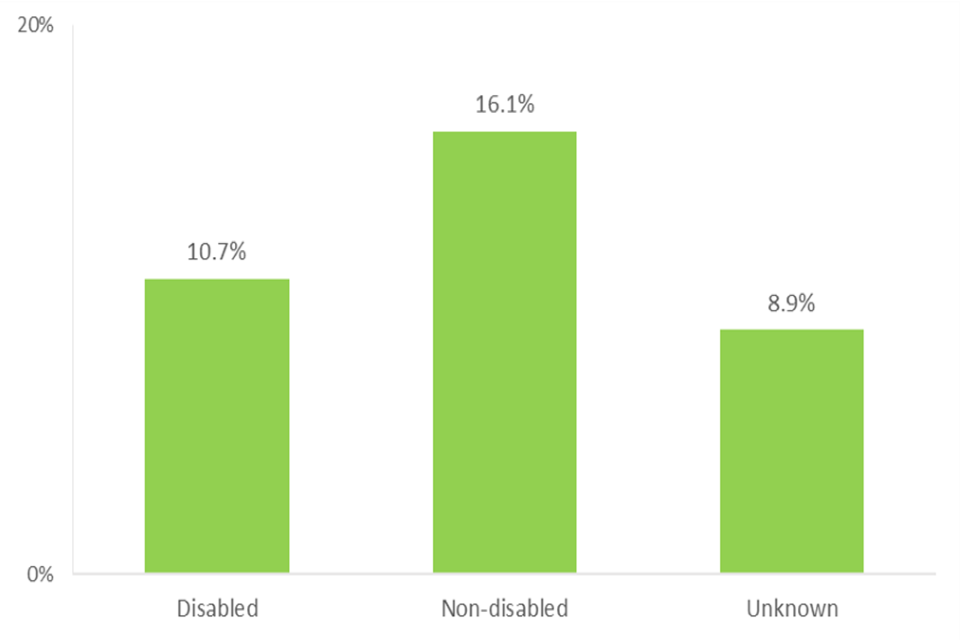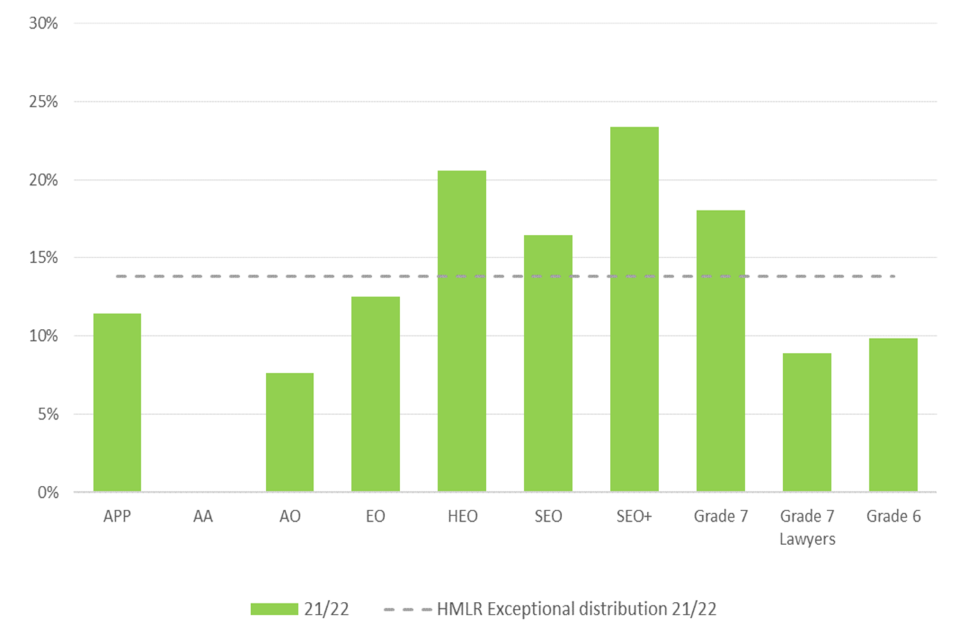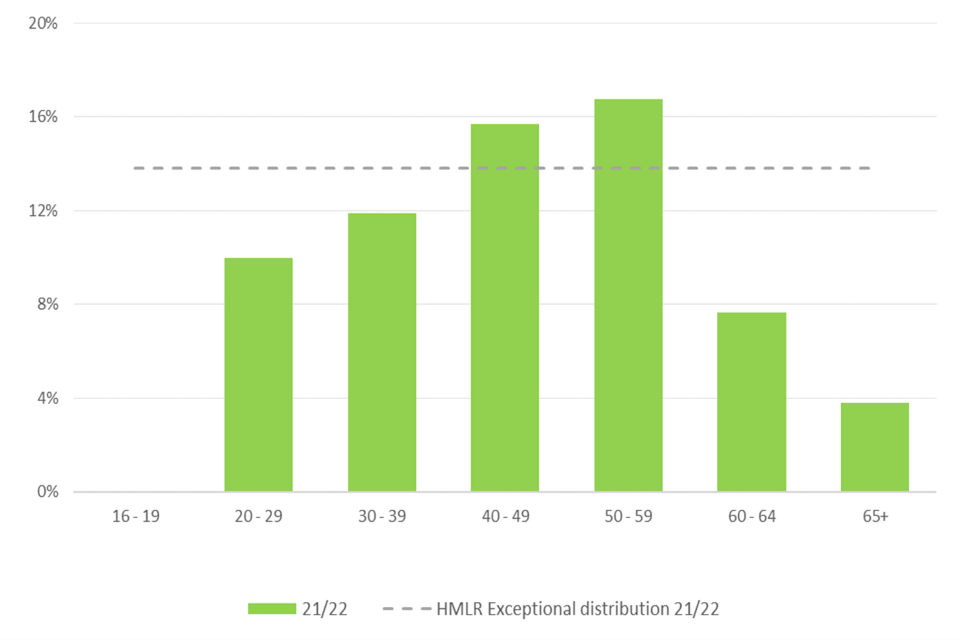Equality Information Report 2021 to 2022
Published 31 October 2022
Applies to England and Wales
1. Our staff
The diversity figures in this report are based on a headcount total of 6,676 members of staff on 31 March 2022 and are taken from HM Land Registry’s Human Resources (HR) system unless otherwise stated. Staff on loan and not paid directly by HM Land Registry are not included in the analysis, nor are agency staff/contractors.
Table 1: Declaration rates held for HM Land Registry workforce
| Protected characteristic | % of workforce with data |
|---|---|
| Gender | 100% |
| Age | 100% |
| Ethnic origin | 84% |
| Disability | 77% |
| Religion and belief | 77% |
| Sexual orientation | 72% |
1.1 Overall workforce
The data presented here shows HM Land Registry’s workforce by protected characteristic at 31 March 2022.
Figure 1: Workforce composition by gender, ethnicity, disability, working pattern, sexual orientation, and age. Positive declarations only, excludes unknown values.
Gender
| Gender | Percentage of staff |
|---|---|
| Male | 39% |
| Female | 61% |
Ethnicity
| Status | Percentage of staff |
|---|---|
| Ethnic minorities | 7% |
| Non-ethnic minorities | 93% |
Disability
| Status | Percentage of staff |
|---|---|
| Declared disabled | 14% |
| Declared non-disabled | 86% |
Working pattern
| Working pattern | Percentage of staff |
|---|---|
| Full time | 69% |
| Part time | 31% |
Sexual orientation
| Sexual orientation | Percentage of staff |
|---|---|
| Other | 0% |
| Lesbian, gay, bisexual (LGB) | 4% |
| Heterosexual | 96% |
Age
| Age | Percentage of staff |
|---|---|
| 65+ | 2% |
| 60-64 | 8% |
| 50-59 | 37% |
| 40-49 | 19% |
| 30-39 | 16% |
| 20-29 | 17% |
| 16-19 | 0% |
1.2 Diversity data by grade
The data presented here shows HM Land Registry’s workforce by grade as percentages in relation to the protected characteristics and working patterns as of 31 March 2022. The data shows positive declarations only.
There are 10 pay grades, plus apprentices (separated for reporting purposes) within HM Land Registry which are shown in the table below with the Civil Service equivalent grade.
Table 2: Grade structure
| HM Land Registry grade | Civil Service grade |
|---|---|
| Senior Civil Service | Senior Civil Service |
| Grade 6 | Grade 6 |
| Grade 7 Lawyers | Grade 7 |
| Grade 7 | Grade 7 |
| Senior Executive Officer (SEO+) | Senior Executive Officer (SEO) |
| Senior Executive Officer (SEO) | Senior Executive Officer (SEO) |
| Higher Executive Officer (HEO) | Higher Executive Officer (HEO) |
| Executive Officer (EO) | Executive Officer (EO) |
| Administrative Officer (AO) | Administrative Officer (AO) |
| Administrative Assistant (AA) | Administrative Assistant (AA) |
| Apprentice (APP) | Apprentice |
Figure 2.1: Percentage of HM Land Registry staff across grades

These figures have been rounded to 1 decimal place.
Figure 2.2: Gender distribution by grade

Figure 2.3: Age distribution by grade

Figure 2.4: Disability distribution by grade

Figure 2.5: Ethnicity distribution by grade

Figure 2.6: Working pattern distribution by grade

1.3 Leavers
The data analysis presented here shows the reasons why employees leave the organisation in relation to each of the following protected characteristics: gender, ethnicity and disability. Working pattern has also been included. Between 1 April 2021 and 31 March 2022, 406 staff left HM Land Registry.
Figure 3.1: Percentage of total leavers by reason

Figure 3.2: Percentage of reason for leaving by gender in relation to total number of leavers in that group
| Gender | Leavers | % Dismissal | % Resignation | % Retirement | % Other |
|---|---|---|---|---|---|
| Female | 229 | 4.8% | 55.9% | 34.5% | 4.8% |
| Male | 177 | 5.6% | 63.3% | 22.0% | 9.0% |
Figure 3.3: Percentage of reasons for leaving by indicated ethnicity in relation to total number of leavers in that group
| Ethnicity | Leavers | % Dismissal | % Resignation | % Retirement | % Other |
|---|---|---|---|---|---|
| Ethnic minorities | 49 | 8.2% | 73.5% | 6.1% | 12.2% |
| Non-ethnic minorities | 260 | 5.0% | 49.2% | 38.8% | 6.9% |
| Unknown | 97 | 4.1% | 78.4% | 14.4% | 3.1% |
Figure 3.4: Percentage of reasons for leaving by indicated disability in relation to total number of leavers in that group
| Disability | Leavers | % Dismissal | % Resignation | % Retirement | % Other |
|---|---|---|---|---|---|
| Disabled | 47 | 12.8% | 25.5% | 36.2% | 25.5% |
| Non-disabled | 212 | 3.3% | 48.6% | 44.3% | 3.8% |
| Unknown | 147 | 5.4% | 85.0% | 4.8% | 4.8% |
Figure 3.5: Percentage of reason for leaving by working pattern in relation to total number of leavers in that group
| Working pattern | Leavers | % Dismissal | % Resignation | % Retirement | % Other |
|---|---|---|---|---|---|
| Full time | 250 | 4.8% | 76.0% | 12.8% | 6.4% |
| Part time | 156 | 5.8% | 32.1% | 55.1% | 7.1% |
1.4 Performance markings
The information below shows the distribution of exceptional performance markings by the protected characteristics: gender, ethnicity, disability and age. We have also included the results on working pattern.
Based on headcount as at 31 March, between 1 April 2021 and 31 March 2022, 98% staff received an appraisal marking. This excludes non-payroll, non-executive director and Senior Civil Service grades.
The 2021/22 performance management process comprised 4 performance ratings and the distribution is shown in the table below.
Table 3: Distribution of performance ratings 2021/22
| Rating | % Distribution |
|---|---|
| Exceptional performing | 13.8% |
| High performing | 31.6% |
| Achieving | 54.1% |
| Underperforming | 0.5% |
Figure 4.1: Top performance markings by gender

Figure 4.2: Top performance markings by ethnicity

Figure 4.3: Top performance markings by disability

Figure 4.4: Top performance markings by grade

Figure 4.5: Top performance markings by working pattern

Figure 4.6: Top performance markings by age

2. Steps taken to ensure due regard to the public sector equality duty
Gender pay gap
Our latest gender pay gap report was published in January 2022 to align with wider government and sets out a refreshed action plan to maintain progress.
Women make up 61% of our workforce but are less well represented at middle and senior management level. His Majesty’s Land Registry 2020/21 Gender pay gap report.
Analysis of our 2021 gender pay gap data suggests the actions we have taken to reduce the pay gap continue to have a positive effect. Our median pay gap reduced from 13.7% in 2020 to 0% this year and our mean pay gap reduced from 8.5% to 7.5%.
Our gender pay gap derives principally from the higher proportion of women in relatively junior roles while being relatively under-represented in most middle to senior management grades. While we pay women the same rate as men for doing the same job, the combined effect of their representation within grades means that currently women earn 7.5% less per hour than men.
We continue to work with staff network’s particularly the women’s network and commit to the actions in our gender pay gap action plan. Our external actions included:
- using inclusive language in job adverts that it is not subtly biased toward one gender (gender decoding)
- adding new wording to job descriptions that are suitable for flexible working ‘Success in this role is not defined by the hours worked, so we can consider a range of working hours and patterns’
- broader advertising of all flexible vacancies, including Timewise Jobs and Mumsnet
- monitoring representation on recruitment panels, to make sure there is a diverse mix
- developing insight sessions on our application and interview processes
Our internal actions included:
- helping recruiting managers to attract diverse applicants by asking them to consider flexibility in their person specification, such as minimum hours, suitable working patterns and only using essential criteria (studies show that women are more likely to hesitate in applying for a job if they do not meet all the listed requirements)
- challenging common misconceptions around part-time working
Recruitment
We have sought to continue to attract, retain and develop diverse talent through innovative recruitment strategies, using social media, employee advocacy and targeted candidate packs. Our recruitment practice is inclusive, ensuring adverts are checked for language and include positive statements. All are open to reasonable adjustments to support the recruitment process.
Work has taken place to improve the disclosure process to encourage openness during HM Land Registry’s recruitment process and recruitment panels have been trained on neurodiversity.
Hybrid working has enabled advertising across all 14 locations and along with remote interviewing, candidates can now apply for roles in any location, which further supports our drive to become an even more diverse workforce.
Recruitment ambassadors
We have set up a network of recruitment ambassadors, providing full social media training to ensure our adverts reach across all communities and holding regular meetings to share best practice. We ensure representation in every local office, focusing initially on ethnic minority ambassadors and now expanding to include all protected characteristics.
Diversity & Inclusion strategy
In April 2021, we published our new Diversity & Inclusion (D&I) strategy for 2020 to 2024 which provides 3 key themes:
- Improving representation
- Creating an inclusive culture
- Embedding D&I outcomes across HM Land Registry
The supporting action plan concentrated on year 1 priorities to:
Develop a baseline of data; provide more focus and support for our employee networks and inclusion champions, provide new initiatives to encourage and support for under-represented groups; review and measure activity against our culture model and embedding D&I into leadership programmes, encourage senior leaders to promote and support diversity networks and inclusion champions; redesign our diversity and inclusion intranet hub page to make all information and support more concise and accessible to everyone.
Personal diversity data declaration
We have made changes to how we declare our personal diversity data, to reflect societal changes, and to improve our understanding of who our people are.
We have added new fields around gender identity and caring responsibilities, introduced themes to better understand disability and incorporated questions relating to socio-economic background.
Supportive policies
We have developed a new ‘Carers at Work’ policy and set up an Employee Carers Network after diversity declaration data has shown that 7% of our staff have caring responsibilities with a need for additional support.
We have created a menopause sub-group which is led by the Women’s Network. Group membership continues to grow and offers a safe place of support, information and a place to talk and share experience.
We are creating a new menopause policy, which will provide support, guidance and signposting for anyone affected by the menopause.
In March 2022, we introduced the Great Place to Work for Veterans scheme which guarantees Armed Forces veterans an interview for public sector jobs.
Health and wellbeing
HM Land Registry’s Attendance, Health & Wellbeing Framework aims to provide a holistic approach to health and wellbeing and helps to ensure that we continue to make our organisation a great place to work.
Our framework focuses on four key areas:
- Culture – we will create the right environment to support attendance, health and wellbeing.
- Prevention – we will help ourselves and others to stay healthier and stay in work.
- Intervention – we will ensure that the right support is provided at the right time.
- Return to Work – we will support our people back to work in a timely way.
Supporting mental and physical health
Our supporting Attendance, Health and Wellbeing delivery plan aims to create a culture in HM Land Registry that recognises the importance of health and wellbeing and build an environment that supports and nurtures our physical and mental health.
The pandemic forced our culture to change rapidly with an unexpected and first-time move to mass home working.
We now operate a hybrid working approach which allows colleagues the flexibility of some home working while attending the office according to business and personal requirements.
We ensure colleagues who require workplace adjustments are fully supported as hybrid workers and equipment is provided if required.
-
Our primary focus on employee wellbeing resulted in more regular discussions and support for both mental and physical health and, as a result, we have seen positive improvements in our engagement scores in the Civil Service People Survey and other regular internal Pulse surveys. Our commitment to fairness and inclusion was recognised in our People Survey with an 88% positive score in inclusion measures, a 2% increase from the previous year.
-
We launched our new Wellbeing Hub which provides a one-stop shop for practical advice and support. The Hub includes 12 wellbeing categories with information and signposting on mental wellbeing, including men’s and women’s health, families, relationships, caring, seasonal wellbeing, financial wellbeing, wellbeing in the workplace, bereavement, general health and fitness, illnesses and chronic conditions, social wellbeing and neurodiversity.
We launched a new Grief Support Network and Bereavement Toolkit and we have provided group sessions for grief counselling through our health advisory service.
- This year, HM Land Registry was awarded a GOLD Award in the MIND Workplace Wellbeing Index. A gold award means that HM Land Registry was rated as successfully embedding mental health into our policies and practices, using a variety of best practice approaches and demonstrating a long-term, in-depth commitment to colleague mental health.
Our Mental Health First Aiders support colleagues with any mental health concerns and promote mental health awareness, with blogs and webinars, supporting Time to Talk Day; Mental Health Awareness Week; World Mental Health Day; World Suicide Prevention Day; and National Grief Awareness Week.
We have supported them in their roles by providing refresher training to ensure their skills and knowledge are up to date.
- As a Disability Confident Leader, we continue to ensure that disabled people and those with long-term health conditions are fully supported and have opportunities to fulfil their potential. We offer the Disability Confident guaranteed interview scheme and ensure all our panel members are trained on supporting disabled and neurodiverse colleagues.
We have consulted with our Disabled Employee Network to update workplace adjustment passports and ensured network members are involved in our software user and accessibility testing.
Our employee networks
We have six brilliant employee networks.
- Age Network, a place for colleagues of all ages to discuss age-related issues and promote awareness and fair treatment for everyone regardless of age.
- REACH Network (Race, Ethnicity, Culture and Heritage), a network for everyone, regardless of ethnicity, which seeks to improve the representation of staff across all grades. The network’s name was changed this year to ensure it reflects all ethnicities.
- Disabled Employee Network, a network for disabled employees, carers and people who are passionate about disability rights.
- Faith and Belief Network, which promotes an awareness and understanding of all faiths and beliefs and encourages people to bring their whole selves to work.
- Pride (Staff Network for Sexual Orientation and Gender Identity).
- Women’s Network, a secure and supportive community providing guidance and advice in areas such as parental leave, returning to work, work-life balance, and physical and mental wellbeing.
Diversity & Inclusion awareness activities
We have continued to raise awareness of D&I by providing continued support and information across the organisation via blogs and webinars.
These were organised and written mainly by our staff diversity networks with support from our communications team, Organisation, Education and Development team, our network of Inclusion Champions and local office diversity representatives.
Table 4: Network activities throughout the year
| Network | Activity (for example, communication, engagement, development, events) |
|---|---|
| REACH (Race Ethnicity and Cultural Heritage Network) |
Blogs:
Events:
|
| Disabled Employee Network |
Blogs raising awareness of:
#thisisme − a selection of articles raising awareness of:
|
| Faith and Belief Network |
Newsletters/blogs raising awareness of:
Events:
|
| PRIDE Network |
Events:
|
| Women’s Network |
Blogs:
|
Our staff networks have continually supported network members and their allies with regular contact, signposting, blogs and online events, all of which support inclusion and champion diversity in our organisation.
As a result, we have seen significantly higher Civil Service People Survey scores for diversity and inclusion, including a 2% uplift, where 93% of employees feel they are “treated with respect by the people I work with” and 90% feel “I am treated fairly at work”.
3. Activity planned to ensure due regard to the Public sector equality duty in 2022 to 2023
We will continue to build an inclusive culture and reputation that attracts, develops and fully engages diverse talent, and increases representation from under-represented groups, underpinned by improved data and metrics.
Menopause policy
We will publish our new menopause policy which will include best practice and recommendations from Civil Service Human Resources and other government departments.
Sixty-one per cent of our employees are women and this policy will give managers appropriate guidance on how to support anyone experiencing symptoms of menopause.
Providing appropriate support will be a step towards ensuring talent and skills are retained, and that any impact on productivity and performance due to menopausal symptoms is minimised.
We will also adapt our existing sickness absence reporting system to include an absence code specifically for menopause-related absences.
Bullying, victimisation and harassment policy
We will update our bullying, victimisation and harassment policy, provide updated training for our harassment officers and continue to highlight our zero-tolerance approach towards all forms of bullying, harassment and inappropriate behaviour, through blogs and awareness sessions.
Gender reassignment policy
We will update and rename our existing policy to ‘Gender Identity and Intersex policy’. The new policy will incorporate other gender identities and reflect current terminology.
Neurodiversity network
Colleagues have worked together to produce a business case for HM Land Registry’s first neurodiversity network, which will represent neurodiverse staff and allies. The network will also support line mangers of neurodiverse staff and provide introductory neurodiversity training for all managers.
The network will be working closely with HM Land Registry’s Training Academy to ensure all training is appropriate for neurodiverse individuals.
4. List of figures and tables
Find the graphs, charts and tables you need.
Tables:
- Table 1: Declaration rates held for HM Land Registry workforce
- Table 2: Grade structure
- Table 3: Distribution of performance ratings 2021/22
- Table 4: Network activities throughout the year
Figures:
- Figure 1: Workforce composition by gender, ethnicity, disability, working pattern, sexual orientation, and age. Positive declarations only, excludes unknown values.
- Figure 2.1: Percentage of HM Land Registry staff across grades
- Figure 2.2: Gender distribution by grade
- Figure 2.3: Age distribution by grade
- Figure 2.4: Disability distribution by grade
- Figure 2.5: Ethnicity distribution by grade
- Figure 2.6: Working pattern distribution by grade
- Figure 3.1: Percentage of total leavers by reason
- Figure 3.2: Percentage of reason for leaving by gender in relation to total number of leavers in that group
- Figure 3.3: Percentage of reasons for leaving by indicated ethnicity in relation to total number of leavers in that group
- Figure 3.4: Percentage of reasons for leaving by indicated disability in relation to total number of leavers in that group
- Figure 3.5: Percentage of reason for leaving by working pattern in relation to total number of leavers in that group
- Figure 4.1: Top performance markings by gender
- Figure 4.2: Top performance markings by ethnicity
- Figure 4.3: Top performance markings by disability
- Figure 4.4: Top performance markings by grade
- Figure 4.5: Top performance markings by working pattern
- Figure 4.6: Top performance markings by age

